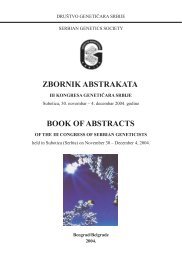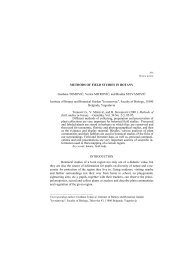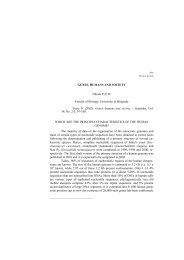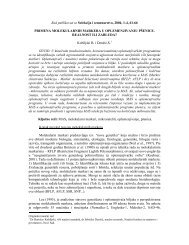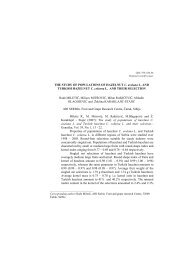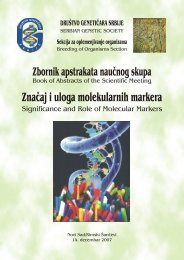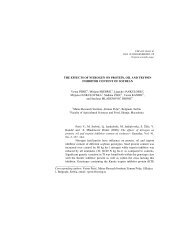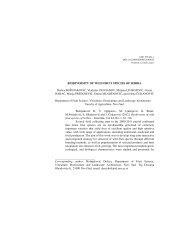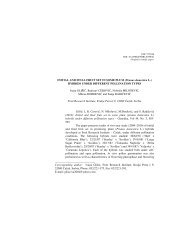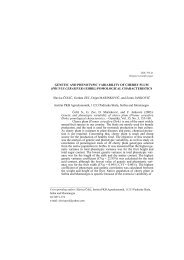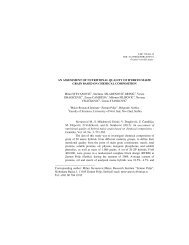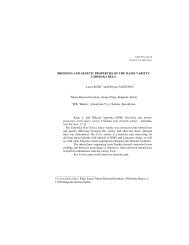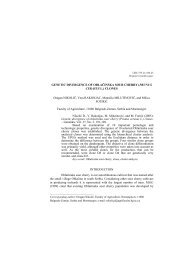HARMONIZATION OF RULES FOR VCU TESTING OF MAIZE IN ...
HARMONIZATION OF RULES FOR VCU TESTING OF MAIZE IN ...
HARMONIZATION OF RULES FOR VCU TESTING OF MAIZE IN ...
You also want an ePaper? Increase the reach of your titles
YUMPU automatically turns print PDFs into web optimized ePapers that Google loves.
UDC 633.15<br />
Review article<br />
<strong>HARMONIZATION</strong> <strong>OF</strong> <strong>RULES</strong> <strong>FOR</strong> <strong>VCU</strong> <strong>TEST<strong>IN</strong>G</strong> <strong>OF</strong> <strong>MAIZE</strong> <strong>IN</strong><br />
COMPARABLE AGRO-ECOLOGICAL REGIONS<br />
J. VAN WAES<br />
Ministry of the Flemish Community, Agricultural Research Centre, Department of<br />
Crop Husbandry & Ecophysiology, Burg. Van Gansberghelaan 109, 9820<br />
Merelbeke, Belgium<br />
Van Waes J. (2004): Harmonization of rules for <strong>VCU</strong> testing of<br />
maize in comparable agro-ecological regions. – Genetika, Vol. 36, No. 1,<br />
1-11.<br />
In the European Community, a new variety of an agricultural<br />
crop must submit official trials for DUS (Distinctness, Uniformity, Stability)<br />
and <strong>VCU</strong> (Value for Cultivation and Use) before commercialisation.<br />
The guidelines for those tests are summarized in the European directive<br />
70/457/EU (1970), revised in 2002 (2002/53/EU). The result of<br />
the <strong>VCU</strong>-tests is the admission on the national variety catalogue of new<br />
varieties, which are better than the best existing ones. Better varieties in<br />
the market can increase the income of the farmers. The progress in<br />
breeding can be measured by comparison the level of recent with older<br />
(10 - 15 years ago) varieties. Incorporation of new varieties in the culture<br />
plan is only justified if they are better than existing varieties and if they<br />
have no great weaknesses. Therefore the farmers need criteria for cultivation<br />
security and high return (output, yield). The two most important factors<br />
for cultivation security are resistance to lodging and to stalk rot. In<br />
addition earliness is another important factor for silage maize to attain a<br />
sufficient dry matter of the total plant and for corn maize to attain a low<br />
moisture content in the grains. Important factors for cost-effectiveness are<br />
total dry matter yield and quality for silage and grain yield for corn maize.<br />
_______________________________<br />
Corresponding author: J. Van Waes, Ministry of the Flemish Community, Agricultural<br />
Research Centre, Department of Crop Husbandry & Ecophysiology, Burg. Van<br />
Gansberghelaan 109, 9820 Merelbeke, Belgium<br />
e-mail: j.vanwaes@clo.fgov.be
2 GENETIKA, Vol. 36, No. 1, 1-11, 2004.<br />
Until now each EU- country has a separate system for <strong>VCU</strong> testing. The<br />
aim of the <strong>VCU</strong>-research is to predict the agronomical and technological<br />
value of a new variety on a reliable way in comparison with standard varieties.<br />
For this purpose there is the necessity for a high number of field<br />
trials and analyses; this implicates high national experimentation costs.<br />
But the costs for experimentation are only a small fraction of the benefits<br />
for the farmers. International cooperation for <strong>VCU</strong>-testing will become<br />
necessary to reduce the costs for the national variety testing systems.<br />
However the aim of the research must still be to predict the agronomical<br />
value of a new variety with the same reliability as at national level. For<br />
the future variety testing should be realised on the basis of comparable<br />
agro-ecological regions with the same crop husbandry and use of the<br />
crop. These regions must be clearly defined so that the release of varieties<br />
corresponds to the high demands for harvest security and good conservation<br />
possibilities of the harvested material. The most important criteria for<br />
evaluation should be: harvest security, disease resistance, yield and quality.<br />
The basis for a good success for international cooperation is a good<br />
knowledge of the national systems: searching for similarities and finding<br />
a solution for differences. Once a variety on a catalogue in one European<br />
country, the breeding company tries to sell the variety in the whole agroecological<br />
for which the variety is adapted. Therefore it is important that<br />
in the surrounding zones, where the variety is tested, the same criteria are<br />
valid. In this presentation we will give a proposal for harmonization and<br />
international cooperation for controlling the <strong>VCU</strong>- value of new maize<br />
varieties. Key words: maize, variety research, international cooperation, costs,<br />
benefits<br />
<strong>IN</strong>TRODUCTION<br />
Maize is an important crop in the world. Together with rice and wheat it<br />
belongs to the three crops with the greatest area in the world.<br />
Table 1 – Evolution of silage and corn maize varieties in Belgium during the period 1991 –<br />
2001 (basis: 5 best silage and corn maize varieties of the recommended list ; Van Waes et<br />
al., (1991a; 1991b; 2001)<br />
Silage maize Corn maize<br />
Total dry matter yield ↑ 0.85 % /year (rel.) Grain yield ↑ 2.8 % /year (rel.)<br />
Total digestible organic<br />
dry matter yield<br />
↑ 1.2 % /year (rel.)<br />
Dry matter content of<br />
the grains<br />
↑ 0.4 % /year (rel.)<br />
Dry matter content of the<br />
total plant<br />
↑ 0.8 % /year (rel.)<br />
Resistance to lodging<br />
(scale 1-9)<br />
↑ from 7.0 till 8.2<br />
Resistance to lodging<br />
(scale 1-9)<br />
↑ from 6.9 till 8.5<br />
Resistance to stalk rot<br />
↑ from 7.2 till 8.4<br />
(scale 1-9)<br />
Resistance to stalk rot<br />
(scale 1-9)<br />
↑ from 7.0 till 8.9
J. VAN WAES: <strong>HARMONIZATION</strong> <strong>OF</strong> <strong>RULES</strong> <strong>FOR</strong> <strong>VCU</strong> <strong>TEST<strong>IN</strong>G</strong> 3<br />
The cost-effectiveness of the maize growing depends on many factors.<br />
One of these is variety choice. Within the assortment of maize, there is a quick<br />
evolution. To calculate the evolution from 1991 till 2001 for silage and corn maize,<br />
the average for yield of the 5 best varieties of the recommended list in Belgium in<br />
1991 was compared with 2001 (Table 1). Actually the best silage maize varieties<br />
attain a higher yield, are earlier (which is in favour for the dry matter content, even<br />
in a bad autumn), have a better quality (digestibility) and have a better harvest security<br />
(resistance to lodging and to stalk rot).<br />
For corn maize the new varieties are higher yielding, are earlier (lower<br />
moisture content in the grains which result in lower drying costs) and have a better<br />
harvest security (resistance to lodging and to stalk rot).<br />
This evolution during the past decade is due to the progress in breeding<br />
and to the severe criteria for registration on the variety catalogue; cultivation techniques<br />
were nearly not changed during this period.<br />
Farmers are confronted with the question why they have to incorporate<br />
the best new varieties in their culture plan. The reason is that the best varieties stay<br />
at maximum 3 to 4 years at the top (Table 2). So a switch-over to new varieties is<br />
necessary to profit continuously of the progress in breeding. However incorporation<br />
of new varieties in the culture plan is only justified if the new varieties have no<br />
great weaknesses and if they are better than existing ones. This can be from the<br />
point of view of the farmers translated into a need for cultivation security and high<br />
return (yield).<br />
Table 2 - Evolution of silage and corn maize varieties (based on the recommended variety<br />
list 2001 – Van Waes et al., (2001)<br />
Silage maize (basis: DOM-yield)<br />
Top 5 : 4/5 < 3 years on the catalogue ; 5/5 < 5 years on the catalogue<br />
Top 10: 8/10 < 3 years on the catalogue ; 10/10 < 5 years on the catalogue<br />
Corn maize (basis: grain yield)<br />
Top 5 : 3/5 < 3 years on the catalogue ; 4/5 < 5 years on the catalogue<br />
Top 10: 6/10 < 3 years on the catalogue ; 9/10 < 5 years on the catalogue<br />
The most important factors for harvest security are resistance to lodging<br />
and stalk rot, resistance to diseases and pests, a sufficient dry matter content of the<br />
total plants for silage maize and a low moisture content in the grains for corn<br />
maize.<br />
For the cost-effectiveness a high total dry matter yield, combined with a<br />
high quality, is obligatory for silage maize while for corn maize the determining<br />
factor is grain yield.<br />
To have an idea about the value of these factors (cultivation security and<br />
cost-effectiveness), the farmers need reliable and neutral information about new<br />
varieties in comparison with the best existing ones. This information comes out of<br />
the variety research programmes, which are regulated in a European context.
4 GENETIKA, Vol. 36, No. 1, 1-11, 2004.<br />
In this article the European regulation concerning variety testing is briefly<br />
described and compared to the actual situation in the different countries. In addition<br />
the costs vs. benefits of the variety testing are evaluated. Furthermore the steps<br />
for international cooperation and the advantages are evaluated.<br />
EUROPEAN REGULATION CONCERN<strong>IN</strong>G VARIETY <strong>TEST<strong>IN</strong>G</strong><br />
In the European Community, a new variety of an agricultural crop must<br />
submit official trials for DUS (Distinctness, Uniformity, Stability) and <strong>VCU</strong><br />
(Value for Cultivation and Use) before commercialisation. The guidelines for those<br />
tests are summarized in the European directive 70/457/EU – 1970, revised<br />
2002/53/EU –2002 (1).The aim of these directives is on one side to protect breeding<br />
companies (breeders right) and on the other side to protect the farmers (only<br />
admission of varieties which are better then existing ones). The condition for a<br />
sufficient <strong>VCU</strong>-value is necessary for admission on a national variety catalogue.<br />
National admission means that from that moment the variety can be multiplied<br />
(seed production) and be commercialised. With the recently adapted European<br />
regulation, once a variety is admitted in one country of the European Community,<br />
it can be added to the European catalogue after a few months. This EU-registration<br />
offers the possibility of commercialisation of the variety over the whole European<br />
community.<br />
ACTUAL SITUATION <strong>FOR</strong> <strong>VCU</strong> –<strong>TEST<strong>IN</strong>G</strong> <strong>IN</strong> THE EUROPEAN<br />
COMMUNITY<br />
Until now each European country has a separate <strong>VCU</strong>- testing system.<br />
The aim of the <strong>VCU</strong>-research is derived from the EU-directive and can be translated<br />
to a national level in the prediction on a neutral and reliable way of the agronomical<br />
and technical value of a new variety, in comparison with standard varieties.<br />
Therefore a high number of trials and quality analyses per year are necessary.<br />
In the case of silage and corn maize in Belgium respectively 7 and 6 trials were set<br />
up in the different agricultural regions. A high number of trials and analyses results<br />
in high experimentation costs. These costs have to be paid by the breeders on one<br />
side and the farmers (Government) on the other side.<br />
COSTS VS. BENEFITS <strong>FOR</strong> <strong>VCU</strong> –<strong>TEST<strong>IN</strong>G</strong><br />
The total costs for <strong>VCU</strong>-research for silage and corn maize, based on the<br />
number of trials mentioned in point 3, are respectively estimated on 150.000 and<br />
105.000 euro per year in Belgium.<br />
The fact that only the best new varieties are registered on the national<br />
catalogue offers potential benefits for the farmers. Better varieties in the market<br />
can result in an increase in income.<br />
How can the progress of maize varieties been calculated for the farmers?<br />
In this study we have based our calculation on the level of the 5 best varieties of<br />
the recommended list in 1991 (VAN WAES et al., 1991a; 1991b) and 2001 (VAN
J. VAN WAES: <strong>HARMONIZATION</strong> <strong>OF</strong> <strong>RULES</strong> <strong>FOR</strong> <strong>VCU</strong> <strong>TEST<strong>IN</strong>G</strong> 5<br />
WAES et al., 2001). For silage, respectively corn, the parameter for calculating of<br />
the evolution were the total digestible organic dry matter yield DOM-yield) and the<br />
grain yield. In order to have data, which were more reflecting to practical conditions,<br />
the yield data from the variety trials were reduced with 10 % (see Table 3).<br />
Table 3 – Costs versus benefits of <strong>VCU</strong>- testing of silage and corn maize varieties in<br />
Belgium<br />
Silage maize Corn maize<br />
Cost<br />
Total <strong>VCU</strong> costs (*) 150.000 euro 105.000 euro<br />
Number of ha in 2001 166.000 ha 36.000 ha<br />
Costs per ha for <strong>VCU</strong> 0.9 euro 2.9 euro<br />
Benefit<br />
Average yield level in practice 13.120 kg DOM /ha 10.280 kg Grains/ha<br />
Increase in yield 1.2 % DOM = 157 kg 2.8 % Grains = 288 kg<br />
Price per kg 1 kg DOM = 0.095 euro 1 kg Grains = 0.1 euro<br />
Benefit per ha 157 x 0.095 = 14.9 euro 288 x 0.1 = 28.8 euro<br />
Costs vs. benefits<br />
(*) <strong>VCU</strong>: Value for Cultivation and Use<br />
0.9 : 14.9 = 6 % 2.9 : 28.8 = 10 %<br />
For silage maize the evolution results in an increase of 157 kg DOM per<br />
ha per year, which corresponds with a financial value of 14.9 euro per ha per year.<br />
For corn maize this results in an increase of 290 kg grains per ha per year, which<br />
corresponds with a financial value of 29.1 euro per ha per year.<br />
Based on the <strong>VCU</strong>-costs and the potential benefits, and taken into account<br />
the yearly sown area with maize in Belgium, the costs versus benefits can be calculated<br />
(Table 3).<br />
For silage maize the costs are only 6 % of the benefits. For corn they are<br />
somewhat higher (10 %) but still only a fraction of the potential benefits.<br />
After an analysis the most important cost factors are: mechanization of the<br />
experimentation (sowing, harvest), quality analyses, number of varieties in the trials.<br />
For the benefits vs. costs the increase in yield per year is important but also the<br />
growing area in Belgium is a determining factor.<br />
COMMENTS ON THE ACTUAL SITUATION <strong>FOR</strong> <strong>VCU</strong>- <strong>TEST<strong>IN</strong>G</strong><br />
Nevertheless the low <strong>VCU</strong>-costs per ha, the actual <strong>VCU</strong>-testing system,<br />
situated at national level in each country of the European community, has some<br />
important disadvantages.<br />
First of all, due to the separate system per country, for which a sufficient<br />
number of trials and analyses are obligatory to predict the <strong>VCU</strong>-value of a new<br />
variety, the national experimentation costs are still high.<br />
Secondly the results are only valuable for national conditions and are not<br />
related to the potential of a new variety, created for a broad agro-ecological zone.
6 GENETIKA, Vol. 36, No. 1, 1-11, 2004.<br />
So to give a positive answer to these comments, variety testing based on<br />
international cooperation can be the solution.<br />
<strong>IN</strong>TERNATIONAL COOPERATION<br />
The aims of international cooperation for <strong>VCU</strong>-tests should be: 1° to predict<br />
the agronomical value of a new variety for the whole agro-ecological zone<br />
where the variety can be cultivated and 2° to predict the agronomical value with<br />
the same reliability as at national level. This second point is very important for the<br />
users (farmers) of the new varieties.<br />
The basis for success for international cooperation is first of all a good<br />
knowledge of the different national systems, searching for similarities and differences.<br />
The most important similarities between the different national variety<br />
testing systems are:<br />
a) evaluation of new varieties in comparison with the best standard varieties,<br />
b) a lot of common varieties,<br />
c) comparable field implantation protocols and harvest modalities,<br />
d) judging of nearly the same characteristics: yield, earliness, resistance to<br />
lodging and stalk rot<br />
Important differences are:<br />
a) a different system for registration of varieties on the national catalogue<br />
(index of characteristics, level of standard varieties)<br />
b) a different preparation of the seeds (disinfection)<br />
c) evaluation for earliness: all groups together or separated<br />
d) plant density in function of the earliness group<br />
e) different quality characteristics and applied methods for analysis (classical<br />
wet analyses, NIRS)<br />
To harmonize the national systems the following steps are proposed:<br />
Step1: Evaluation of the national systems (preparation of seeds and field<br />
protocol, evaluation criteria, etc.)<br />
Step 2: Comparison of data of common varieties for different quantitative<br />
and qualitative characteristics<br />
Step 3: Definition of agro-ecological zones<br />
Step 4: Data processing based on the national systems and on the whole<br />
agro-ecological zone<br />
Step 5: Selection of locations for an international network (genotype x<br />
environment interactions)<br />
Step 6: Implantation of an international network with common varieties<br />
Step 7: Evaluation of the results of this network after a testing cycle of 2<br />
till 3 years<br />
Step 8: Proposal for adaptation of the EU-rules for direct registration at<br />
the European catalogue
J. VAN WAES: <strong>HARMONIZATION</strong> <strong>OF</strong> <strong>RULES</strong> <strong>FOR</strong> <strong>VCU</strong> <strong>TEST<strong>IN</strong>G</strong> 7<br />
An important step is number 3, namely to define the agro-ecological<br />
zones. Three criteria are therefore important:<br />
a) Which maize type can be cultivated (looking to the earliness)?<br />
b) What is (are) the actual practice(s) in the potential cultivation zone?<br />
c) Which criteria are important for variety release in the defined agroecological<br />
zone? The whole zone is maybe theoretically good for cultivation of a<br />
variety with a specific FAO-index but other climatic conditions (differences in<br />
disease pressure, high risks for storms in autumn) can lead to different criteria for<br />
registration of varieties and split up of the agro-ecological zone.<br />
As a model for defining agro-ecological zones heat units (Fig. 1) or the<br />
FAO- index for earliness (Fig. 2) can be used. In the second model a lot of overlapping<br />
between the zones exists.<br />
Fig. 1. International cooperation – Agroecological zones (<strong>IN</strong>RA – AGPM)<br />
The final result of an international variety testing network should be a<br />
registration of a new variety directly at the European catalogue.<br />
The result of testing varieties in agro-ecological zones, over the national<br />
borders, will be a win-win situation for all partners in the chain of variety testing.<br />
For the breeders their registration costs will be lower, due to only one application<br />
for the European catalogue, while actually a lot of varieties are tested at
8 GENETIKA, Vol. 36, No. 1, 1-11, 2004.<br />
the same time in several EU-countries. Furthermore they will have the data of the<br />
whole zone in which the variety can be cultivated; this offers more possibilities for<br />
commercialization.<br />
For the national institutes, responsible for organizing the official trials, an<br />
international cooperation can result in lower experimentation costs (reduced number<br />
of trials per country) but maintenance of the same level of reliability for the<br />
prediction of the performance of a new variety.<br />
Fig. 2. International cooperation – Agroecological zones (FAO, KWS)<br />
Based on an international network it will be possible to deliver to the<br />
farmers neutral and objective information of all varieties, which can be cultivated<br />
in the same agro-ecological zone. They will no more be depended of supplementary<br />
data of trials after registration,<br />
CONCLUSIONS<br />
Variety research is regulated at European level and is important for both<br />
breeders and farmers.
J. VAN WAES: <strong>HARMONIZATION</strong> <strong>OF</strong> <strong>RULES</strong> <strong>FOR</strong> <strong>VCU</strong> <strong>TEST<strong>IN</strong>G</strong> 9<br />
A good variety choice is an important factor for the cost-effectiveness of<br />
maize growing.<br />
The experimentation costs for a well structured <strong>VCU</strong>-testing network are<br />
high but they are only a small fraction of the potential benefits for the farmers.<br />
Until now the <strong>VCU</strong>- trials are situated at national level and are not related<br />
to agro-ecological zones.<br />
To reduce the experimentation costs international cooperation for field trials,<br />
based on agro-ecological zones, offers possibilities. Before an international<br />
network can be operational different steps have to be passed through. Finally this<br />
can lead to direct registration at the European catalogue. This will be a win-win<br />
situation for all partners, dealing with variety research (breeders, official institutes,<br />
farmers, agro - industry).<br />
REFERENCES<br />
Received November 4 th , 2003<br />
Accepted January 30 th 2004<br />
anonymous (2002) Council directive 2002/53/EC of the 13th of June 2002 of the common catalogue of<br />
varieties of agricultural plant species. Official Journal of the European Communities, L<br />
193/1 – 11.<br />
VAN WAES J., A. DE VLIEGHER, and J.L. HERMAN (1991a) – Catalogue belge des variétés de<br />
maïs à ensiler : description et recommendation, RvP-CLO Ghent, 17 p.<br />
VAN WAES J., A. DE VLIEGHER, and J.L. HERMAN (1991b) – Catalogue belge des variétés de<br />
maïs grain : description et recommendation, RvP-CLO Ghent, 6 p.<br />
VAN WAES J., N. DE BEL, A. DE VLIEGHER, L. CARLIER, and J.L. HERMAN (2001) – Catalogue<br />
belge des variétés de plantes fourragères et engrais verts : description et recommendation.<br />
1ère édition; DFE-CLO Ghent, 103 p.
10 GENETIKA, Vol. 36, No. 1, 1-11, 2004.<br />
USKLAĐIVANJE PRAVILA ZA <strong>VCU</strong> ISPITIVANJE KUKURUZA U<br />
UPOREDIVIM AGRO-EKOLOŠKIM REJONIMA<br />
J. VAN WAES<br />
Ministarstvo flamanske zajednice, Centar za poljoprivredna istraživanja,<br />
Odsek/Sektor za ratarstvo i ekofiziologiju, Burg. Van Gansberghelaan 109, 9820<br />
Merelbeke, Belgija<br />
Izvod<br />
U Evropskoj Zajednici svaka nova sorta bilo kog poljoprivrednog useva<br />
pre uvođenja u proizvodnju mora biti ispitana u zvaničnim DUS (različitost, ujednačenost,<br />
stabilnost) i <strong>VCU</strong> (vrednost za gajenje i upotrebu) ogledima. Smernice za<br />
ova ispitivanja su ukratko izložena u Evropskoj direktivi 70/457/EU (1970), koja je<br />
revidirana 2002. godine (2002/53/EU). Rezultat <strong>VCU</strong>-ispitivanja je unošenje novih<br />
sorti u katalog nacionalnih sorti, koje su bolje od dosadašnjih najboljih sorti. Bolje<br />
sorte na tržištu mogu da uvećaju prihod farmera. Napredak u oplemenjivanju se<br />
može meriti upoređivanjem nivoa novijih i starijih (od pre 10-15 godina) sorti.<br />
Unošenje novih sorti u plan gajenja useva opravdano je samo onda ako su te sorte<br />
bolje od postojećih i ako nemaju većih nedostataka. Stoga su farmerima potrebni<br />
kriterijumi za pouzdano gajenje i dobre rezultate (prihod, prinos). Dva najvažnija<br />
činioca za pouzdano gajenje su otpornost prema poleganju i truleži stabla. Takođe,<br />
ranostasnost je jedan od važnijih činilaca da bi kukuruz za silažu imao dovoljno<br />
suve materije čitave biljke i da bi kukuruz za zrno imao nizak nivo vlage u zrnu.<br />
Važni činioci ekonomičnosti su ukupna suva materija i kvalitet za kukuruz za silažu<br />
i prinos zrna za kukuruz za zrno. Do sada je svaka država EZ imala svoj<br />
posebni sistem za <strong>VCU</strong> ispitivanje. Cilj <strong>VCU</strong>-istraživanja je da predvidi agronomsku<br />
i tehnološku vrednost novih sorti na pouzdan način u poređenju sa standardnim<br />
sortama. Da bi se to postiglo potreban je veliki broj poljskih ogleda i analiza; ovo<br />
podrazumeva velike troškove za eksperimente na nivou države. Međutim, ovi<br />
troškovi su samo mali deo u odnosu na korist koju će imati farmeri. Međunarodna<br />
saradnja na <strong>VCU</strong>-ispitivanjima postaće neophodna za snižavanje troškova za nacionalne<br />
sisteme za ispitivanje sorti. Međutim, cilj ispitivanja i dalje mora da obezbediti<br />
predviđanje agronomske vrednosti nove sorte sa istom pouzdanošću kao što<br />
je to bilo na nacionalnom nivou. Buduća ispitivanja sorti bi trebalo da se izvode u<br />
uporedivim agro-ekološkim rejonima sa istim načinom gajenja i upotrebe useva.<br />
Ovi rejoni moraju biti jasno definisani tako da priznavanje sorti odgovara visokim<br />
zahtevima za bezbednu berbu i mogućnostima za dobro čuvanje obranog materijala.<br />
Najvažniji kriterijumi za ocenjivanje bi trebalo da budu: bezbednost berbe,<br />
otpornost prema bolestima, prinos i kvalitet. Osnova za uspešnu međunarodnu<br />
saradnju je dobro poznavanje nacionalnih sistema: traganje za sličnostima i
J. VAN WAES: <strong>HARMONIZATION</strong> <strong>OF</strong> <strong>RULES</strong> <strong>FOR</strong> <strong>VCU</strong> <strong>TEST<strong>IN</strong>G</strong> 11<br />
iznalaženje rešenja za različitosti. Selekcionarska kuća pokušava da, sortu jednom<br />
kada se nađe u katalogu jedne od evropskih država, proda u čitavom agro-ekološkom<br />
regionu za koji je sorta prilagođena. Zato je važno da u okolnim oblastima,<br />
u kojima se sorta ispituje, važe isti kriterijumi. U ovom prikazu iznećemo predlog<br />
za usklađivanje i za međunarodnu saradnju koja se odnosi na kontrolu <strong>VCU</strong>-vrednosti<br />
novih sorti kukuruza.<br />
Primljeno 4 XI 2003.<br />
Odobreno 30. I 2004.



